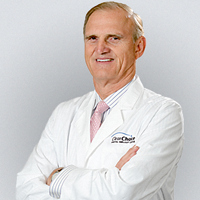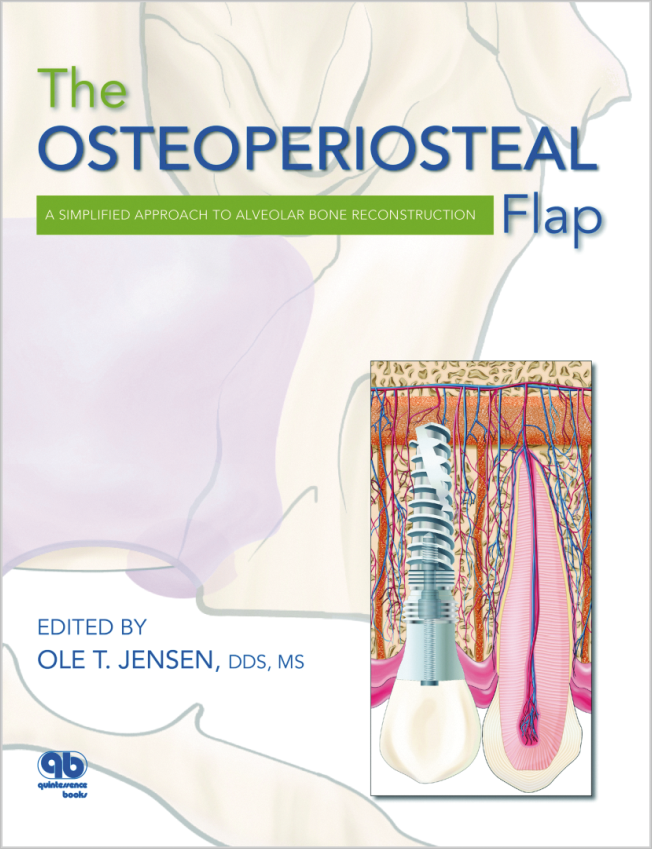The International Journal of Oral & Maxillofacial Implants, 5/2023
DOI: 10.11607/jomi.10694, PubMed-ID: 37847825Seiten: 838-840, Sprache: EnglischJensen, Ole T. / Albrektsson, Tomas / Jemt, TorstenThe International Journal of Oral & Maxillofacial Implants, 5/2021
DOI: 10.11607/jomi.2021.5.eSeiten: 843-844, Sprache: EnglischJensen, Ole T. / Weiss, Ervin / Grainger, David W.The International Journal of Oral & Maxillofacial Implants, 1/2015
DOI: 10.11607/jomi.3977, PubMed-ID: 25615925Seiten: 202-207, Sprache: EnglischMisch, Craig M. / Jensen, Ole T. / Pikos, Michael A. / Malmquist, Jay P.Purpose: This retrospective study evaluated the use of a composite graft of recombinant human bone morphogenetic protein-2 (rhBMP-2) and particulate mineralized bone allograft protected by a titanium mesh for vertical bone augmentation.
Materials and Methods: A review of data on patients from four oral and maxillofacial surgery practices in the United States who required vertical augmentation prior to implant treatment was conducted. Vertical augmentation was accomplished with rhBMP-2 in an absorbable collagen sponge (ACS) carrier and particulate allograft. Cone beam computed tomography was used to measure vertical bone gains using this technique.
Results: Sixteen vertical ridge augmentation procedures were performed in 15 patients. The maximum vertical bone gains ranged from 4.4 to 16.3 mm. The average maximum vertical bone gain was 8.53 mm. The procedure allowed implant placement in all patients. Forty implants were inserted into the grafted ridges after a minimum of 6 months of healing. All implants integrated and were used for prosthetic support.
Conclusion: This study suggests that rhBMP-2/ACS and particulate mineralized bone allograft protected by a titanium mesh offers favorable vertical bone gains to allow dental implant placement.
Schlagwörter: cone beam computed tomography, recombinant human bone morphogenetic protein-2, titanium mesh, vertical bone augmentation
The International Journal of Oral & Maxillofacial Implants, 2/2014
Online OnlyDOI: 10.11607/jomi.te59, PubMed-ID: 24683586Seiten: 232-240, Sprache: EnglischJensen, Ole T. / Adams, Mark W.Purpose: Primary stability of dental implants, particularly when they are placed into immediate function in the maxilla, has been thought to be required. An alternative to primary stability is secondary stabilization, which can be obtained by a four-implant distribution pattern using 30-degree angulations for all four implants in the so-called "M-4" treatment scheme in combination with cross-arch stabilization from a prosthesis. If successful, the use of these two measures brings into question whether or not primary stability is required for immediate function in the maxilla.
Materials and Methods: Patients were treated with the M-4 implant scheme with immediate function, despite the instability of at least one of the four implants. Instability was defined as less than 15 Ncm of insertion torque and palpable mobility, and an average anteroposterior spread of 15 mm between each implant was sought. The patients were followed for 1 year.
Results: Ten patients were treated with a total of 40 implants. Composite insertion torque of the four implants was less than 100 Ncm in half of the patients; the average anteroposterior spread was 15.6 mm. After 1 year, no implants had been lost, and bone levels around all implants were at or near operative levels. There were no failures of provisional or definitive prostheses.
Conclusions: M-4 distribution of implants with an average of 15 mm of anteroposterior spread and cross-arch stabilization did not require that all four implants had high insertion torque; in fact, all mobile implants stabilized and osseointegrated under these conditions.
Schlagwörter: All-on-Four, anteroposterior spread, composite insertion torque, cross-arch stabilization, immediate function maxilla, insertion torque, M-4, primary stability, secondary stabilization
The International Journal of Oral & Maxillofacial Implants, 1/2014
Online OnlyDOI: 10.11607/jomi.te39, PubMed-ID: 24451885Seiten: 30-35, Sprache: EnglischJensen, Ole T. / Cottam, Jared R. / Ringeman, Jason L. / Graves, Stuart / Beatty, Lucas / Adams, Mark W.Purpose: To report on the use of angled implants placed into the vomer/nasal crest to support a complete-arch maxillary prosthesis.
Materials and Methods: Consecutive patients were treated with the All-on-Four concept to restore the maxillary dentition. When bone volume in the subnasal region was inadequate, angled implants were placed into the vomer/nasal crest area to support the restoration. All implants were loaded immediately.
Results: One hundred consecutive maxillary All-on-Four patients were treated over a period of 2 years. Four hundred six implants were placed; 12 were inserted into the vomer/nasal crest area. One year later, at definitive restoration, the 12 vomer implants were found to be osseointegrated without bone loss or instability.
Conclusions: Midline maxillary bone volume at the nasal crest appeared to be a viable alternative to the lateral nasal rim when subnasal bone was deficient. Vomer implants allowed for immediate function or were sometimes used as a rescue implant when an anterior implant failed.
Schlagwörter: All-on-Four protocol, M point, nasal crest, vomer implant, vomer/nasal crest bone mass, V point
The International Journal of Oral & Maxillofacial Implants, 1/2014
Online OnlyDOI: 10.11607/jomi.te44, PubMed-ID: 24451890Seiten: 66-72, Sprache: EnglischLaviv, Amir / Ringeman, Jason / Debecco, Meir / Jensen, Ole T. / Casap, NardyPurpose: This study sought to confirm, through histologic evaluation, the vitality and viability of the island osteoperiosteal flap (i-flap) in a rabbit tibia model.
Materials and Methods: In four rabbits, an osteotomy was performed on the tibial aspect of the right leg. A bone flap was raised, but the periosteal attachment was kept intact. The free-floating i-flap was separated from the rest of the bone by a silicone sheet. The rabbits were to be sacrificed after 1, 2, 4, and 8 weeks and histologic samples examined.
Results: All surgeries were accomplished successfully; however, three animals showed fractured tibiae within a few days after surgery and were sacrificed immediately after the fractures were discovered. The fourth rabbit was sacrificed at 4 weeks. Histologic specimens showed vital new bone in the i-flap area and signs of remodeling in the transition zone and the original basal bone.
Conclusion: The i-flap remained vital. This suggests potential for use in bone augmentation strategies, particularly for the alveolar split procedure.
Schlagwörter: alveolar split osteotomy, bone augmentation, island osteoperiosteal flap, rabbit model, tibia
The International Journal of Oral & Maxillofacial Implants, 1/2014
Online OnlyDOI: 10.11607/jomi.te46, PubMed-ID: 24451892Seiten: 81-94, Sprache: EnglischJensen, Ole T. / Kuhlke, K. Lee / Leopardi, Aldo / Adams, Mark W. / Ringeman, Jason L.This report presents seven patients who were treated with combined alveolar split/sinus grafting technique and dental implants and followed for 1 to 3 years. The grafting material included bone morphogenetic protein-2 in an absorbable collagen sponge plus allograft. The procedure was successful in all patients, who received implants either simultaneously with grafting or 4 to 6 months after grafting.
Schlagwörter: allografts, alveolar split osteotomy, bone morphogenetic protein, book flap, dental implants, i-flap, interpositional bone grafting, sinus elevation
The International Journal of Oral & Maxillofacial Implants, 1/2014
Online OnlyDOI: 10.11607/jomi.te48, PubMed-ID: 24451877Seiten: 103-105, Sprache: EnglischJensen, Ole T. / Lehman, Hadas / Ringeman, Jason L. / Casap, NardyThe engineering, design, manufacture, and rationale for use of printed titanium shells for alveolar bone reconstruction using BMP-2/ACS/allograft are described. This is proposed as a possible improvement to the current hand-configured mesh graft technique in common use today.
Schlagwörter: alveolar bone graft, graft containment, titanium mesh, titanium shell
The International Journal of Oral & Maxillofacial Implants, 1/2014
Online OnlyDOI: 10.11607/jomi.te52, PubMed-ID: 24451881Seiten: 130-138, Sprache: EnglischJensen, Ole T. / Adams, Mark W. / Smith, EdmundParanasal bone affects the decision-making process for placement of implants for immediate function in the highly resorbed maxilla. The most important bone for apical fixation of implants in this setting is the lateral nasal bone mass. Maximum available bone mass found at the pyriform above the nasal fossa, designated M point, can most often engage two implants placed at 30-degree angles. The second most important area of paranasal bone mass is the subnasal bone of the premaxilla, which is required to engage an angled implant at the alveolar crest. However, only 4 to 5 mm in height is needed when implants are angled posterior to engage M point. The third most important paranasal bone site for implant fixation is the midline nasal crest extending upward to the vomer. This site, which is usually type 1/2 bone, can engage implants apically and provide enough fixation for immediate function even if implants are short. These anatomical bone sites enable placement of implants to obtain a 12- to 15-mm anterior-posterior spread, which is favorable for immediate function.
Schlagwörter: anterior-posterior spread, immediate function, M-4, M point, pyriform rim, V point, vomer/nasal crest, zygomatic implants
The International Journal of Oral & Maxillofacial Implants, 6/2013
Online OnlyDOI: 10.11607/jomi.te14, PubMed-ID: 24278951Seiten: 331-348, Sprache: EnglischJensen, Ole T. / Cottam, Jared R. / Ringeman, Jason L. / Leopardi, Aldo / Butler, Brian / Laviv, Amir / Fleissig, Yoram / Casapz, NardyThis paper is a retrospective report of the treatment of six patients with severely resorbed maxillae. Patients were treated, based on the amount of maxillary retrognathia, with either a Le Fort I downfracture or a "horseshoe" interpositional sandwich osteotomy, along with sinus elevation. Recombinant human bone morphogenetic protein-2 in an absorbable collagen sponge carrier was used for grafting in all patients, either alone or in combination with other grafting materials. Implants were placed and the patients were restored with fixed prostheses. Both grafting techniques are described, and the treated patients are presented.





